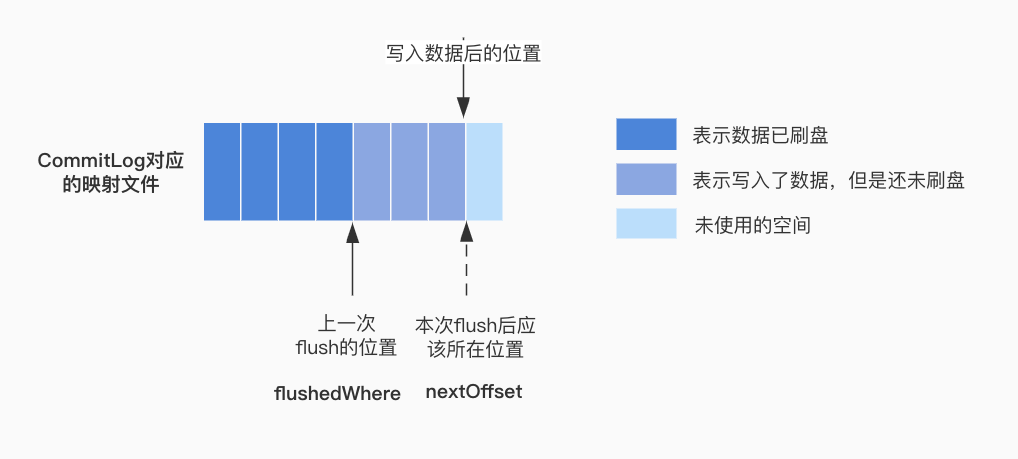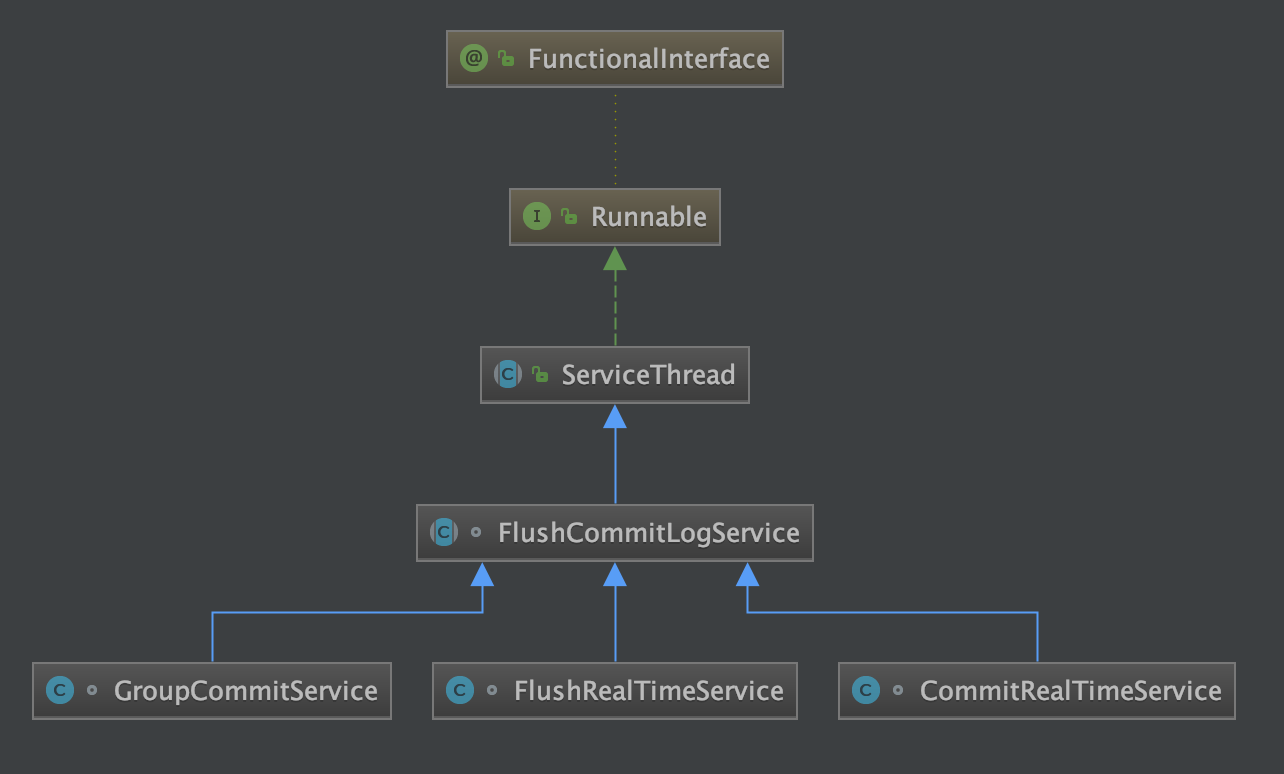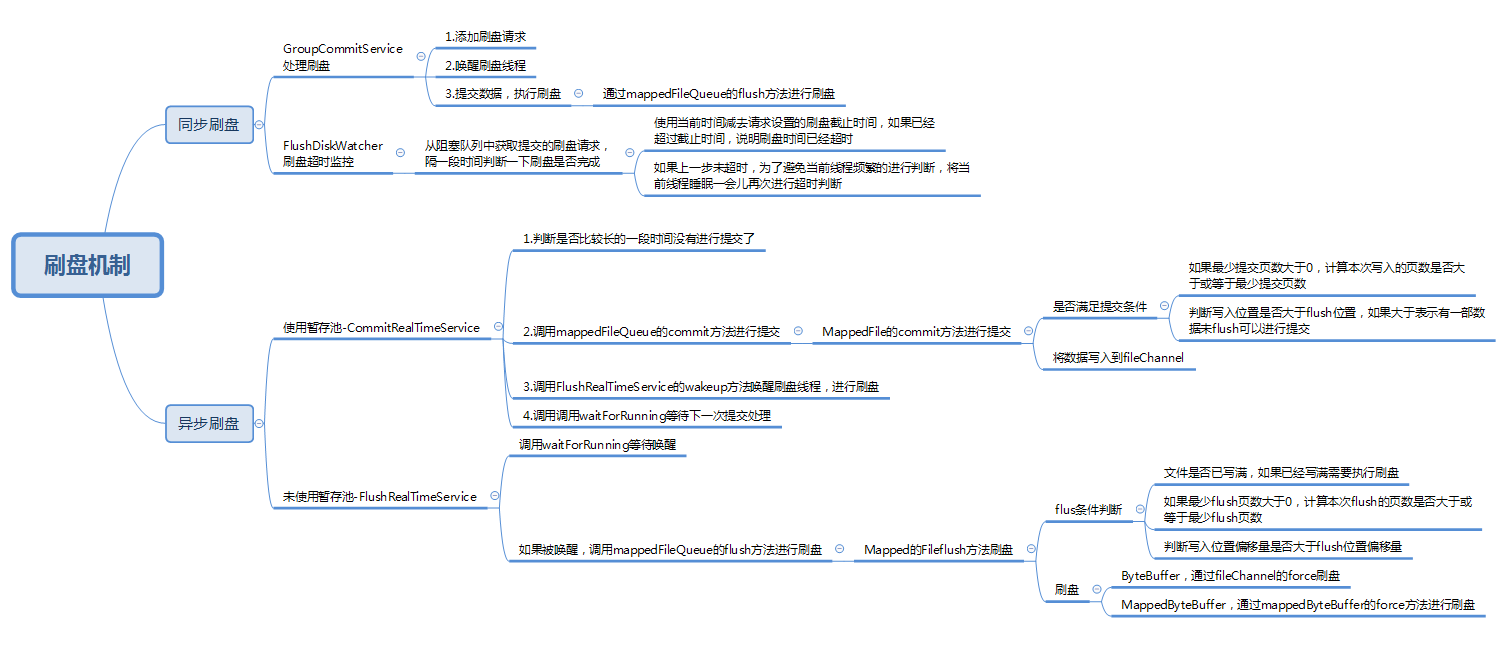CommitLog的asyncPutMessage方法中可以看到在写入消息之后,调用了submitFlushRequest方法执行刷盘策略:
public class CommitLog {
public CompletableFuture<PutMessageResult> asyncPutMessage(final MessageExtBrokerInner msg) {
// ...
try {
// 获取上一次写入的文件
MappedFile mappedFile = this.mappedFileQueue.getLastMappedFile();
// ...
// 写入消息
result = mappedFile.appendMessage(msg, this.appendMessageCallback, putMessageContext);
// ...
} finally {
beginTimeInLock = 0;
putMessageLock.unlock();
}
// ...
// 执行刷盘
CompletableFuture<PutMessageStatus> flushResultFuture = submitFlushRequest(result, msg);
// ...
}
}
刷盘有两种策略:
-
同步刷盘,表示消息写入到内存之后需要立刻刷到磁盘文件中。
同步刷盘会构建
GroupCommitRequest组提交请求并设置本次刷盘后的位置偏移量的值(写入位置偏移量+写入数据字节数),然后将请求添加到flushDiskWatcher和GroupCommitService中进行刷盘。 -
异步刷盘,表示消息写入内存成功之后就返回,由MQ定时将数据刷入到磁盘中,会有一定的数据丢失风险。
public class CommitLog {
// 监控刷盘
private final FlushDiskWatcher flushDiskWatcher;
public CompletableFuture<PutMessageStatus> submitFlushRequest(AppendMessageResult result, MessageExt messageExt) {
// 是否是同步刷盘
if (FlushDiskType.SYNC_FLUSH == this.defaultMessageStore.getMessageStoreConfig().getFlushDiskType()) {
// 获取GroupCommitService
final GroupCommitService service = (GroupCommitService) this.flushCommitLogService;
// 是否等待
if (messageExt.isWaitStoreMsgOK()) {
// 构建组提交请求,传入本次刷盘后位置的偏移量:写入位置偏移量+写入数据字节数
GroupCommitRequest request = new GroupCommitRequest(result.getWroteOffset() + result.getWroteBytes(),
this.defaultMessageStore.getMessageStoreConfig().getSyncFlushTimeout());
// 添加到wather中
flushDiskWatcher.add(request);
// 添加到service
service.putRequest(request);
// 返回
return request.future();
} else {
service.wakeup();
return CompletableFuture.completedFuture(PutMessageStatus.PUT_OK);
}
}
// 如果是异步刷盘
else {
if (!this.defaultMessageStore.getMessageStoreConfig().isTransientStorePoolEnable()) {
flushCommitLogService.wakeup();
} else {
commitLogService.wakeup();
}
return CompletableFuture.completedFuture(PutMessageStatus.PUT_OK);
}
}
}
如果使用的是同步刷盘,首先获取了GroupCommitService,然后构建GroupCommitRequest组提交请求,将请求添加到flushDiskWatcher和GroupCommitService中,其中flushDiskWatcher用于监控刷盘是否超时,GroupCommitService用于提交刷盘数据。
构建GroupCommitRequest提交请求
GroupCommitRequest是CommitLog的内部类:
- nextOffset:写入位置偏移量+写入数据字节数,也就是本次刷盘成功后应该对应的flush偏移量
- flushOKFuture:刷盘结果
- deadLine:刷盘的限定时间,值为当前时间 + 传入的超时时间,超过限定时间还未刷盘完毕会被认为超时
public class CommitLog {
public static class GroupCommitRequest {
private final long nextOffset;
// 刷盘状态
private CompletableFuture<PutMessageStatus> flushOKFuture = new CompletableFuture<>();
private final long deadLine;// 刷盘的限定时间,超过限定时间还未刷盘完毕会被认为超时
public GroupCommitRequest(long nextOffset, long timeoutMillis) {
this.nextOffset = nextOffset;
// 设置限定时间:当前时间 + 超时时间
this.deadLine = System.nanoTime() + (timeoutMillis * 1_000_000);
}
public void wakeupCustomer(final PutMessageStatus putMessageStatus) {
// 结束刷盘,设置刷盘状态
this.flushOKFuture.complete(putMessageStatus);
}
public CompletableFuture<PutMessageStatus> future() {
// 返回刷盘状态
return flushOKFuture;
}
}
}
GroupCommitService处理刷盘
GroupCommitService是CommitLog的内部类,从继承关系中可知它实现了Runnable接口,在run方法调用waitForRunning等待刷盘请求的提交,然后处理刷盘,不过这个线程是在什么时候启动的呢?
public class CommitLog {
/**
* GroupCommit Service
*/
class GroupCommitService extends FlushCommitLogService {
// ...
// run方法
public void run() {
CommitLog.log.info(this.getServiceName() + " service started");
while (!this.isStopped()) {
try {
// 等待刷盘请求的到来
this.waitForRunning(10);
// 处理刷盘
this.doCommit();
} catch (Exception e) {
CommitLog.log.warn(this.getServiceName() + " service has exception. ", e);
}
}
// ...
}
}
}
在BrokerController的启动方法中,可以看到调用了messageStore的start方法,前面可知使用的是DefaultMessageStore,进入到DefaultMessageStore的start方法,它又调用了commitLog的start方法,在CommitLog的start方法中,启动了刷盘的线程和监控刷盘的线程:
public class BrokerController {
public void start() throws Exception {
if (this.messageStore != null) {
// 启动
this.messageStore.start();
}
// ...
}
}
public class DefaultMessageStore implements MessageStore {
/**
* @throws Exception
*/
public void start() throws Exception {
// ...
this.flushConsumeQueueService.start();
// 调用CommitLog的启动方法
this.commitLog.start();
this.storeStatsService.start();
// ...
}
}
public class CommitLog {
private final FlushCommitLogService flushCommitLogService; // 刷盘
private final FlushDiskWatcher flushDiskWatcher; // 监控刷盘
private final FlushCommitLogService commitLogService; // commitLogService
public void start() {
// 启动刷盘的线程
this.flushCommitLogService.start();
flushDiskWatcher.setDaemon(true);
// 启动监控刷盘的线程
flushDiskWatcher.start();
if (defaultMessageStore.getMessageStoreConfig().isTransientStorePoolEnable()) {
this.commitLogService.start();
}
}
}
既然知道了线程在何时启动的,接下来详细看一下GroupCommitService是如何处理刷盘提交请求的。
前面知道在GroupCommitService的run方法中,调用了waitForRunning方法等待刷盘请求,waitForRunning在GroupCommitService父类ServiceThread中实现。ServiceThread是一个抽象类,实现了Runnable接口,里面使用了CountDownLatch进行线程间的通信,大小设为1。
waitForRunning方法在进入的时候先判断hasNotified是否为true(已通知),并尝试将其更新为false(未通知),由于hasNotified的初始化值为false,所以首次进入的时候条件不成立,不会进入到这个处理逻辑,会继续执行后面的代码。
接着调用 waitPoint的reset方法将其重置为1,并调用waitPoint的await方法进行等待:
// ServiceThread
public abstract class ServiceThread implements Runnable {
// 是否通知,初始化为false
protected volatile AtomicBoolean hasNotified = new AtomicBoolean(false);
// CountDownLatch用于线程间的通信
protected final CountDownLatch2 waitPoint = new CountDownLatch2(1);
// 等待运行
protected void waitForRunning(long interval) {
// 判断hasNotified是否为true,并尝试将其更新为false
if (hasNotified.compareAndSet(true, false)) {
// 调用onWaitEnd
this.onWaitEnd();
return;
}
// 重置waitPoint的值,也就是值为1
waitPoint.reset();
try {
// 会一直等待waitPoint值降为0
waitPoint.await(interval, TimeUnit.MILLISECONDS);
} catch (InterruptedException e) {
log.error("Interrupted", e);
} finally {
// 是否被通知设置为false
hasNotified.set(false);
this.onWaitEnd();
}
}
}
一、添加刷盘请求,唤醒刷盘线程
上面可知需要刷盘的时候调用了GroupCommitService的putRequest方法添加刷盘请求,在putRequest方法中,将刷盘请求GroupCommitRequest添加到了requestsWrite组提交写请求链表中,然后调用wakeup方法唤醒刷盘线程,wakeup方法在它的父类ServiceThread中实现。
在wakeup方法中可以看到,首先将hasNotified更改为了true表示处于已通知状态,然后调用了countDown方法,此时waitPoint值变成0,就会唤醒之前waitForRunning方法中一直在等待的线程。
public class CommitLog {
/**
* 组提交Service
*/
class GroupCommitService extends FlushCommitLogService {
// 组提交写请求链表
private volatile LinkedList<GroupCommitRequest> requestsWrite = new LinkedList<GroupCommitRequest>();
// ...
// 添加提交请求
public synchronized void putRequest(final GroupCommitRequest request) {
// 加锁
lock.lock();
try {
// 加入到写请求链表
this.requestsWrite.add(request);
} finally {
lock.unlock();
}
// 唤醒线程执行提交任务
this.wakeup();
}
// ...
}
}
// ServiceThread
public abstract class ServiceThread implements Runnable {
// CountDownLatch用于线程间的通信
protected final CountDownLatch2 waitPoint = new CountDownLatch2(1);
// 唤醒刷盘线程
public void wakeup() {
// 更改状态为已通知状态
if (hasNotified.compareAndSet(false, true)) {
// waitPoint的值减1,由于大小设置为1,减1之后变为0,会唤醒等待的线程
waitPoint.countDown();
}
}
// ...
}
二、线程被唤醒,执行刷盘前的操作
waitForRunning方法中的await方法一直在等待countdown的值变为0,当上一步调用了wakeup后,就会唤醒该线程,然后开始往下执行,在finally中可以看到将是否被通知hasNotified又设置为了false,然后调用了onWaitEnd方法,GroupCommitService方法中重写了该方法,里面又调用了swapRequests方法将读写请求列表的数据进行了交换,putRequest方法中将提交的刷盘请求放在了写链表中,经过交换,数据会被放在读链表中,后续进行刷盘时会从读链表中获取请求进行处理:
// ServiceThread
public abstract class ServiceThread implements Runnable {
// CountDownLatch
protected final CountDownLatch2 waitPoint = new CountDownLatch2(1);
// 等待运行
protected void waitForRunning(long interval) {
if (hasNotified.compareAndSet(true, false)) {
// 交换
this.onWaitEnd();
return;
}
// 重置
waitPoint.reset();
try {
// 会一直等待countdown为0
waitPoint.await(interval, TimeUnit.MILLISECONDS);
} catch (InterruptedException e) {
log.error("Interrupted", e);
} finally {
// 是否被通知设置为false
hasNotified.set(false);
this.onWaitEnd();
}
}
}
public class CommitLog {
/**
* 组提交Service
*/
class GroupCommitService extends FlushCommitLogService {
// 组提交写请求链表
private volatile LinkedList<GroupCommitRequest> requestsWrite = new LinkedList<GroupCommitRequest>();
// 组提交读请求链表
private volatile LinkedList<GroupCommitRequest> requestsRead = new LinkedList<GroupCommitRequest>();
@Override
protected void onWaitEnd() {
// 交换读写请求列表的数据请求
this.swapRequests();
}
private void swapRequests() {
// 加锁
lock.lock();
try {
// 将读写请求链表的数据进行交换
LinkedList<GroupCommitRequest> tmp = this.requestsWrite;
this.requestsWrite = this.requestsRead;
this.requestsRead = tmp;
} finally {
lock.unlock();
}
}
// ...
}
}
这里使用读写链表进行交换应该是为了提升性能,如果只使用一个链表,在提交请求的时候需要往链表中添加请求,此时需要加锁,而刷盘线程在处理完请求之后是需要从链表中移除请求的,假设添加请求时加的锁还未释放,刷盘线程就要一直等待,而添加和处理完全可以同时进行,所以使用了两个链表,在添加请求的时候使用写链表,处理请求的时候对读写链表的数据进行交换使用读链表,这样只需在交换数据的时候加锁,以此来提升性能。
三、执行刷盘
waitForRunning执行完毕后,会回到GroupCommitService中的run方法开始继续往后执行代码,从代码中可以看到接下来会调用doCommit方法执行刷盘。
doCommit方法中对读链表中的数据进行了判空,如果不为空,进行遍历处理每一个提交请求,处理逻辑如下:
- 获取CommitLog映射文件记录的刷盘位置偏移量
flushedWhere,判断是否大于请求设定的刷盘位置偏移量nextOffset,正常情况下flush的位置应该小于本次刷入数据后的偏移量,所以如果flush位置大于等于本次请求设置的flush偏移量,本次将不能进行刷盘

-
开启一个循环,调用
mappedFileQueue的flush方法执行刷盘(具体的实现在异步刷盘的时候再看),由于CommitLog大小为1G,所以本次刷完之后,如果当前已经刷入的偏移量小于请求设定的位置,表示数据未刷完,需要继续刷,反之表示数据已经刷完,flushOK为true,for循环条件不满足结束执行。 -
请求处理之后会清空读链表。
public class CommitLog {
/**
* 组提交Service
*/
class GroupCommitService extends FlushCommitLogService {
// 运行
public void run() {
CommitLog.log.info(this.getServiceName() + " service started");
// 如果没有停止
while (!this.isStopped()) {
try {
// 等待唤醒刷盘线程
this.waitForRunning(10);
// 进行提交
this.doCommit();
} catch (Exception e) {
CommitLog.log.warn(this.getServiceName() + " service has exception. ", e);
}
}
// 睡眠10毫秒
try {
Thread.sleep(10);
} catch (InterruptedException e) {
CommitLog.log.warn(this.getServiceName() + " Exception, ", e);
}
synchronized (this) {
this.swapRequests();
}
// 停止之前提交一次
this.doCommit();
CommitLog.log.info(this.getServiceName() + " service end");
}
// 提交刷盘
private void doCommit() {
// 如果不为空
if (!this.requestsRead.isEmpty()) {
// 遍历刷盘请求
for (GroupCommitRequest req : this.requestsRead) {
// 获取映射文件的flush位置,判断是否大于请求设定的刷盘位置
boolean flushOK = CommitLog.this.mappedFileQueue.getFlushedWhere() >= req.getNextOffset();
for (int i = 0; i < 2 && !flushOK; i++) {
// 进行刷盘
CommitLog.this.mappedFileQueue.flush(0);
// 由于CommitLog大小为1G,所以本次刷完之后,如果当前已经刷入的偏移量小于请求设定的位置,表示数据未刷完,需要继续刷,反之表示数据已经刷完,flushOK为true,for循环条件不满足结束执行
flushOK = CommitLog.this.mappedFileQueue.getFlushedWhere() >= req.getNextOffset();
}
// 设置刷盘结果
req.wakeupCustomer(flushOK ? PutMessageStatus.PUT_OK : PutMessageStatus.FLUSH_DISK_TIMEOUT);
}
long storeTimestamp = CommitLog.this.mappedFileQueue.getStoreTimestamp();
if (storeTimestamp > 0) {
CommitLog.this.defaultMessageStore.getStoreCheckpoint().setPhysicMsgTimestamp(storeTimestamp);
}
// 请求处理完之后清空链表
this.requestsRead = new LinkedList<>();
} else {
// Because of individual messages is set to not sync flush, it
// will come to this process
CommitLog.this.mappedFileQueue.flush(0);
}
}
}
}
FlushDiskWatcher用于监控刷盘请求的耗时,它也继承了ServiceThread,在Broker启动时开启了该线程,在run方法中,使用while循环,只要服务未停止,会一直从阻塞队列中获取提交的刷盘请求,开启while循环隔一段时间判断一下刷盘是否完成,如果未完成,会做如下判断:
- 使用当前时间减去请求设置的刷盘截止时间,如果已经超过截止时间,说明刷盘时间已经超时,调用
wakeupCustomer方法设置刷盘结果为已超时 - 如果未超时,为了避免当前线程频繁的进行判断,将当前线程睡眠一会儿,睡眠的计算方式是使用刷盘请求设置的截止时间 - 当前时间,表示剩余的时间,然后除以1000000化为毫秒,得到距离刷盘截止时间的毫秒数sleepTime:
sleepTime如果为0,只能是当前时间等于截止时间,也就是到了截止时间,此时同样调用wakeupCustomer方法设置刷盘结果为已超时sleepTime不为0,在10毫秒和sleepTime的值之间取较小的那个作为睡眠的毫秒数将当前线程睡眠,等待刷盘任务执行
public class FlushDiskWatcher extends ServiceThread {
private static final InternalLogger log = InternalLoggerFactory.getLogger(LoggerName.STORE_LOGGER_NAME);
// 阻塞队列,存放提交请求
private final LinkedBlockingQueue<GroupCommitRequest> commitRequests = new LinkedBlockingQueue<>();
@Override
public String getServiceName() {
return FlushDiskWatcher.class.getSimpleName();
}
@Override
public void run() {
// 如果未停止
while (!isStopped()) {
GroupCommitRequest request = null;
try {
// 从阻塞队列中获取提交请求
request = commitRequests.take();
} catch (InterruptedException e) {
log.warn("take flush disk commit request, but interrupted, this may caused by shutdown");
continue;
}
// 如果还未完成
while (!request.future().isDone()) {
long now = System.nanoTime();
// 如果已经超时
if (now - request.getDeadLine() >= 0) {
// 设置刷盘结果为超时
request.wakeupCustomer(PutMessageStatus.FLUSH_DISK_TIMEOUT);
break;
}
// 避免频繁的判断,使用(截止时间 - 当前时间)/1000000 计算一个毫秒数
long sleepTime = (request.getDeadLine() - now) / 1_000_000;
// 在计算的毫秒数与10之间取最小的
sleepTime = Math.min(10, sleepTime);
// 如果sleepTime为0表示已经到了截止时间
if (sleepTime == 0) {
// 设置刷盘结果为超时
request.wakeupCustomer(PutMessageStatus.FLUSH_DISK_TIMEOUT);
break;
}
try {
// 睡眠等待刷盘任务的执行
Thread.sleep(sleepTime);
} catch (InterruptedException e) {
log.warn(
"An exception occurred while waiting for flushing disk to complete. this may caused by shutdown");
break;
}
}
}
}
}
上面讲解了同步刷盘,接下来去看下异步刷盘,首先会判断是否使用了暂存池,如果未开启调用flushCommitLogService的wakeup唤醒刷盘线程,否则使用commitLogService先将数据写入到FileChannel,然后统一进行刷盘:
public class CommitLog {
private final FlushDiskWatcher flushDiskWatcher;
public CompletableFuture<PutMessageStatus> submitFlushRequest(AppendMessageResult result, MessageExt messageExt) {
// 是否是同步刷盘
if (FlushDiskType.SYNC_FLUSH == this.defaultMessageStore.getMessageStoreConfig().getFlushDiskType()) {
// ...
}
// 如果是异步刷盘
else {
// 如果未使用暂存池
if (!this.defaultMessageStore.getMessageStoreConfig().isTransientStorePoolEnable()) {
// 唤醒刷盘线程进行刷盘
flushCommitLogService.wakeup();
} else {
// 如果使用暂存池,使用commitLogService,先将数据写入到FILECHANNEL,然后统一进行刷盘
commitLogService.wakeup();
}
// 返回结果
return CompletableFuture.completedFuture(PutMessageStatus.PUT_OK);
}
}
}
在CommitLog的构造函数中可以看到,commitLogService使用的是CommitRealTimeService进行实例化的,flushCommitLogService需要根据设置决定使用哪种类型进行实例化:
- 如果是同步刷盘,使用
GroupCommitService,由前面的同步刷盘可知,使用的就是GroupCommitService进行刷盘的。 - 如果是异步刷盘,使用
FlushRealTimeService。
所以接下来需要关注CommitRealTimeService和FlushRealTimeService:

public class CommitLog {
private final FlushCommitLogService flushCommitLogService;
// 刷盘Service
private final FlushCommitLogService commitLogService;
public CommitLog(final DefaultMessageStore defaultMessageStore) {
// 如果设置的同步刷盘
if (FlushDiskType.SYNC_FLUSH == defaultMessageStore.getMessageStoreConfig().getFlushDiskType()) {
// 使用GroupCommitService
this.flushCommitLogService = new GroupCommitService();
} else {
// 使用FlushRealTimeService
this.flushCommitLogService = new FlushRealTimeService();
}
// commitLogService
this.commitLogService = new CommitRealTimeService();
}
}
CommitRealTimeService

在开启暂存池时,会使用CommitRealTimeService,它继承了FlushCommitLogService,所以会实现run方法,处理逻辑如下:
- 从配置信息中获取提交间隔、每次提交的最少页数和两次提交的最大间隔时间
- 如果当前时间大于上次提交时间+两次提交的最大间隔时间,意味着已经有比较长的一段时间没有进行提交了,需要尽快刷盘,此时将每次提交的最少页数设置为0不限制提交页数
- 调用
mappedFileQueue的commit方法进行提交,并返回提交的结果:- 如果结果为true表示未提交任何数据
- 如果结果为false表示进行了数据提交,需要等待刷盘
- 判断提交返回结果是否返回false,如果是调用
flushCommitLogService的wakeup方法唤醒刷盘线程,进行刷盘 - 调用
waitForRunning等待下一次提交处理
class CommitRealTimeService extends FlushCommitLogService {
// 上次提交时间戳
private long lastCommitTimestamp = 0;
@Override
public void run() {
CommitLog.log.info(this.getServiceName() + " service started");
// 如果未停止
while (!this.isStopped()) {
// 获取提交间隔
int interval = CommitLog.this.defaultMessageStore.getMessageStoreConfig().getCommitIntervalCommitLog();
// 一次提交的最少页数
int commitDataLeastPages = CommitLog.this.defaultMessageStore.getMessageStoreConfig().getCommitCommitLogLeastPages();
// 两次提交的最大间隔时间
int commitDataThoroughInterval =
CommitLog.this.defaultMessageStore.getMessageStoreConfig().getCommitCommitLogThoroughInterval();
// 开始时间
long begin = System.currentTimeMillis();
// 如果当前时间大于上次提交时间+提交的最大间隔时间
if (begin >= (this.lastCommitTimestamp + commitDataThoroughInterval)) {
this.lastCommitTimestamp = begin; // 提交时间
commitDataLeastPages = 0;// 最少提交页数设为0,表示不限制提交页数
}
try {
// 提交
boolean result = CommitLog.this.mappedFileQueue.commit(commitDataLeastPages);
// 提交结束时间
long end = System.currentTimeMillis();
// 如果返回false表示提交了一部分数据但是还未进行刷盘
if (!result) {
// 再次更新提交时间戳
this.lastCommitTimestamp = end;
// 唤醒flush线程进行刷盘
flushCommitLogService.wakeup();
}
if (end - begin > 500) {
log.info("Commit data to file costs {} ms", end - begin);
}
// 等待下一次提交
this.waitForRunning(interval);
} catch (Throwable e) {
CommitLog.log.error(this.getServiceName() + " service has exception. ", e);
}
}
boolean result = false;
for (int i = 0; i < RETRY_TIMES_OVER && !result; i++) {
result = CommitLog.this.mappedFileQueue.commit(0);
CommitLog.log.info(this.getServiceName() + " service shutdown, retry " + (i + 1) + " times " + (result ? "OK" : "Not OK"));
}
CommitLog.log.info(this.getServiceName() + " service end");
}
}
提交的方法在MappedFileQueue的commit方法中实现,处理逻辑如下:
- 根据记录的CommitLog文件提交位置的偏移量获取映射文件,如果获取不为空,调用MappedFile的commit方法进行提交,然后返回本次提交数据的偏移量
- 记录本次提交的偏移量:文件的偏移量 + 提交数据的偏移量
- 判断本次提交的偏移量是否等于上一次的提交偏移量,如果等于表示本次未提交任何数据,返回结果置为true,否则表示提交了数据,等待刷盘,返回结果为false
- 更新上一次提交偏移量
committedWhere的值为本次的提交偏移量的值
public class MappedFileQueue {
protected long flushedWhere = 0; // flush的位置偏移量
private long committedWhere = 0; // 提交的位置偏移量
public boolean commit(final int commitLeastPages) {
boolean result = true;
// 根据提交位置的偏移量获取映射文件
MappedFile mappedFile = this.findMappedFileByOffset(this.committedWhere, this.committedWhere == 0);
if (mappedFile != null) {
// 调用mappedFile的commit方法进行提交,返回提交数据的偏移量
int offset = mappedFile.commit(commitLeastPages);
// 记录本次提交的偏移量:文件的偏移量 + 提交数据的偏移量
long where = mappedFile.getFileFromOffset() + offset;
// 设置返回结果,如果本次提交偏移量等于上一次的提交偏移量为true,表示什么也没干,否则表示提交了数据,等待刷盘
result = where == this.committedWhere;
// 更新上一次提交偏移量的值为本次的
this.committedWhere = where;
}
return result;
}
}
MappedFile
MappedFile中记录CommitLog的写入位置wrotePosition、提交位置committedPosition以及flush位置flushedPosition,在commit方法中,调用了isAbleToCommit判断是否可以提交数据,判断的流程如下:
-
获取提交数据的位置偏移量和写入数据的位置偏移量
-
如果最少提交页数大于0,计算本次写入的页数是否大于或等于最少提交页数
本次写入数据的页数计算方法:写入位置/页大小 - flush位置/页大小
-
如果以上条件都满足,判断写入位置是否大于flush位置,如果大于表示有一部数据未flush可以进行提交
满足提交条件后,就会调用commit0方法提交数据,将数据写入到fileChannel中:
public class MappedFile extends ReferenceResource {
// 数据写入位置
protected final AtomicInteger wrotePosition = new AtomicInteger(0);
// 数据提交位置
protected final AtomicInteger committedPosition = new AtomicInteger(0);
// 数据flush位置
private final AtomicInteger flushedPosition = new AtomicInteger(0);
// 提交数据
public int commit(final int commitLeastPages) {
// 如果writeBuffer为空
if (writeBuffer == null) {
// 不需要提交任何数据到,返回之前记录的写入位置
return this.wrotePosition.get();
}
// 如果可以提交数据
if (this.isAbleToCommit(commitLeastPages)) {
if (this.hold()) {
// 提交数据
commit0();
this.release();
} else {
log.warn("in commit, hold failed, commit offset = " + this.committedPosition.get());
}
}
// All dirty data has been committed to FileChannel.
if (writeBuffer != null && this.transientStorePool != null && this.fileSize == this.committedPosition.get()) {
this.transientStorePool.returnBuffer(writeBuffer);
this.writeBuffer = null;
}
// 返回提交位置
return this.committedPosition.get();
}
// 是否可以提交数据
protected boolean isAbleToCommit(final int commitLeastPages) {
// 获取提交数据的位置偏移量
int flush = this.committedPosition.get();
// 获取写入数据的位置偏移量
int write = this.wrotePosition.get();
if (this.isFull()) {
return true;
}
// 如果最少提交页数大于0
if (commitLeastPages > 0) {
// 写入位置/页大小 - flush位置/页大小 是否大于至少提交的页数
return ((write / OS_PAGE_SIZE) - (flush / OS_PAGE_SIZE)) >= commitLeastPages;
}
// 判断是否需要flush数据
return write > flush;
}
protected void commit0() {
// 获取写入位置
int writePos = this.wrotePosition.get();
// 获取上次提交的位置
int lastCommittedPosition = this.committedPosition.get();
if (writePos - lastCommittedPosition > 0) {
try {
// 创建共享缓冲区
ByteBuffer byteBuffer = writeBuffer.slice();
// 设置上一次提交位置
byteBuffer.position(lastCommittedPosition);
byteBuffer.limit(writePos);
this.fileChannel.position(lastCommittedPosition);
// 数据写入fileChannel
this.fileChannel.write(byteBuffer);
// 更新写入的位置
this.committedPosition.set(writePos);
} catch (Throwable e) {
log.error("Error occurred when commit data to FileChannel.", e);
}
}
}
}
FlushRealTimeService
如果未开启暂存池,会直接使用FlushRealTimeService进行刷盘,当然如果开启暂存池,写入一批数据后,同样会使用FlushRealTimeService进行刷盘,FlushRealTimeService同样继承了FlushCommitLogService,是用于执行刷盘的线程,处理逻辑与提交刷盘数据逻辑相似,只不过不是提交数据,而是调用flush方法将提交的数据刷入磁盘:
- 从配置信息中获取flush间隔、每次flush的最少页数和两次flush的最大间隔时间
- 如果当前时间大于上次flush时间+两次flush的最大间隔时间,意味着已经有比较长的一段时间没有进行flush,此时将每次flush的最少页数设置为0不限制flush页数
- 调用
waitForRunning等待被唤醒 - 如果被唤醒,调用
mappedFileQueue的flush方法进行刷盘
class FlushRealTimeService extends FlushCommitLogService {
private long lastFlushTimestamp = 0; // 上一次flush的时间
private long printTimes = 0;
public void run() {
CommitLog.log.info(this.getServiceName() + " service started");
// 如果未停止
while (!this.isStopped()) {
//
boolean flushCommitLogTimed = CommitLog.this.defaultMessageStore.getMessageStoreConfig().isFlushCommitLogTimed();
// 获取flush间隔
int interval = CommitLog.this.defaultMessageStore.getMessageStoreConfig().getFlushIntervalCommitLog();
// flush至少包含的页数
int flushPhysicQueueLeastPages = CommitLog.this.defaultMessageStore.getMessageStoreConfig().getFlushCommitLogLeastPages();
// 两次flush的时间间隔
int flushPhysicQueueThoroughInterval =
CommitLog.this.defaultMessageStore.getMessageStoreConfig().getFlushCommitLogThoroughInterval();
boolean printFlushProgress = false;
long currentTimeMillis = System.currentTimeMillis();
// 如果当前毫秒数 大于上次flush时间 + 两次flush之间的间隔
if (currentTimeMillis >= (this.lastFlushTimestamp + flushPhysicQueueThoroughInterval)) {
this.lastFlushTimestamp = currentTimeMillis; // 更新flush时间
flushPhysicQueueLeastPages = 0; // flush至少包含的页数置为0
printFlushProgress = (printTimes++ % 10) == 0;
}
try {
//
if (flushCommitLogTimed) {
// 睡眠
Thread.sleep(interval);
} else {
// 等待flush被唤醒
this.waitForRunning(interval);
}
if (printFlushProgress) {
// 打印刷盘进程
this.printFlushProgress();
}
long begin = System.currentTimeMillis();
// 进行刷盘
CommitLog.this.mappedFileQueue.flush(flushPhysicQueueLeastPages);
long storeTimestamp = CommitLog.this.mappedFileQueue.getStoreTimestamp();
if (storeTimestamp > 0) {
CommitLog.this.defaultMessageStore.getStoreCheckpoint().setPhysicMsgTimestamp(storeTimestamp);
}
long past = System.currentTimeMillis() - begin;
if (past > 500) {
log.info("Flush data to disk costs {} ms", past);
}
} catch (Throwable e) {
CommitLog.log.warn(this.getServiceName() + " service has exception. ", e);
this.printFlushProgress();
}
}
// 如果服务停止,确保数据被刷盘
boolean result = false;
for (int i = 0; i < RETRY_TIMES_OVER && !result; i++) {
// 进行刷盘
result = CommitLog.this.mappedFileQueue.flush(0);
CommitLog.log.info(this.getServiceName() + " service shutdown, retry " + (i + 1) + " times " + (result ? "OK" : "Not OK"));
}
this.printFlushProgress();
CommitLog.log.info(this.getServiceName() + " service end");
}
刷盘的方法在MappedFileQueue的flush方法中实现,处理逻辑如下:
- 根据 flush的位置偏移量获取映射文件
- 调用
mappedFile的flush方法进行刷盘,并返回刷盘后的位置偏移量 - 计算最新的flush偏移量
- 更新flushedWhere的值为最新的flush偏移量
public class MappedFileQueue {
protected long flushedWhere = 0; // flush的位置偏移量
private long committedWhere = 0; // 提交的位置偏移量
// flush刷盘
public boolean flush(final int flushLeastPages) {
boolean result = true;
// 获取flush的位置偏移量映射文件
MappedFile mappedFile = this.findMappedFileByOffset(this.flushedWhere, this.flushedWhere == 0);
if (mappedFile != null) {
// 获取时间戳
long tmpTimeStamp = mappedFile.getStoreTimestamp();
// 调用MappedFile的flush方法进行刷盘,返回刷盘后的偏移量
int offset = mappedFile.flush(flushLeastPages);
// 计算最新的flush偏移量
long where = mappedFile.getFileFromOffset() + offset;
result = where == this.flushedWhere;
// 更新flush偏移量
this.flushedWhere = where;
if (0 == flushLeastPages) {
this.storeTimestamp = tmpTimeStamp;
}
}
// 返回flush的偏移量
return result;
}
}
flush的逻辑也与commit方法的逻辑类似:
-
调用
isAbleToFlush判断是否满足刷盘条件,获取上次flush位置偏移量和当前写入位置偏移量进行如下校验:-
文件是否已写满,即文件大小是否与写入数据位置相等,如果相等说明文件已经写满需要执行刷盘,满足刷盘条件
-
如果最少flush页数大于0,计算本次flush的页数是否大于或等于最少flush页数,如果满足可以进行刷盘
本次flush数据的页数计算方法:写入位置/页大小 - flush位置/页大小
-
如果写入位置偏移量是否大于flush位置偏移量,如果大于表示有数据未进行刷盘,满足刷盘条件
-
-
调用
fileChannel的force或者mappedByteBuffer的force方法进行刷盘 -
记录本次flush的位置,并作为结果返回
public class MappedFile extends ReferenceResource {
protected final AtomicInteger wrotePosition = new AtomicInteger(0);
protected final AtomicInteger committedPosition = new AtomicInteger(0);
private final AtomicInteger flushedPosition = new AtomicInteger(0);
/**
* 进行刷盘并返回flush后的偏移量
*/
public int flush(final int flushLeastPages) {
// 是否可以刷盘
if (this.isAbleToFlush(flushLeastPages)) {
if (this.hold()) {
int value = getReadPosition();
try {
// 如果writeBuffer不为空
if (writeBuffer != null || this.fileChannel.position() != 0) {
// 将数据刷到硬盘
this.fileChannel.force(false);
} else {
this.mappedByteBuffer.force();
}
} catch (Throwable e) {
log.error("Error occurred when force data to disk.", e);
}
// 记录flush位置
this.flushedPosition.set(value);
this.release();
} else {
log.warn("in flush, hold failed, flush offset = " + this.flushedPosition.get());
this.flushedPosition.set(getReadPosition());
}
}
// 返回flush位置
return this.getFlushedPosition();
}
// 是否可以刷盘
private boolean isAbleToFlush(final int flushLeastPages) {
// 获取上次flush位置
int flush = this.flushedPosition.get();
// 写入位置偏移量
int write = getReadPosition();
if (this.isFull()) {
return true;
}
// 如果flush的页数大于0,校验本次flush的页数是否满足条件
if (flushLeastPages > 0) {
// 本次flush的页数:写入位置偏移量/OS_PAGE_SIZE - 上次flush位置偏移量/OS_PAGE_SIZE,是否大于flushLeastPages
return ((write / OS_PAGE_SIZE) - (flush / OS_PAGE_SIZE)) >= flushLeastPages;
}
// 写入位置偏移量是否大于flush位置偏移量
return write > flush;
}
// 文件是否已写满
public boolean isFull() {
// 文件大小是否与写入数据位置相等
return this.fileSize == this.wrotePosition.get();
}
/**
* 返回当前有效数据的位置
*/
public int getReadPosition() {
// 如果writeBuffer为空使用写入位置,否则使用提交位置
return this.writeBuffer == null ? this.wrotePosition.get() : this.committedPosition.get();
}
}

